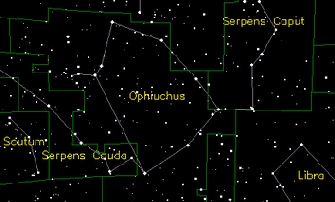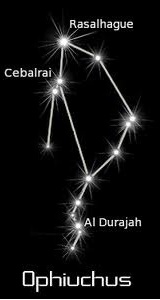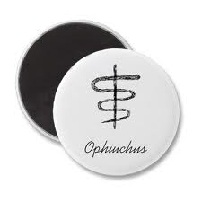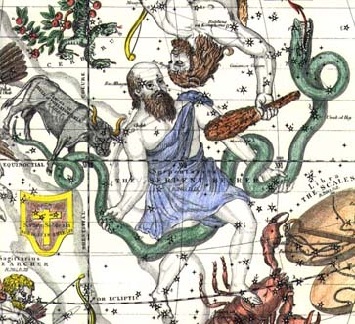advertisements
Ophiuchus
The 13th Constellation
NeptuneCafe presents
This material on this page is excerpted from an article by Michael O'Reilly in the July 2011 issue of Dell Horoscope magazine.
The 13th Sign Phenomenon
Time magazine said it loud and clear to its mainstream audience: due to a slow movement in the earth’s axis over the last 2000 years, the twelve signs of the zodiac have shifted. This means that most people aren’t the sign they think they are. A Gemini may in reality be a Taurus, or heaven forbid, a Scorpio may now be an Ophiuchus.
Signs are not Constellations
The Sign of Ophiuchus?
In spite of the inherent differences between astrologers’ and astronomers’ worldviews, the issue of whether or not a 13th sign should be included in the astrologers’ toolbox remains a controversial issue. Some astrologers have assumed that astronomers know what they’re talking about when they tell astrologers how to run their business.
A casual browsing of online resources will reveal a number of astrologers who are currently offering advice and making forecasts for those born under the “sign” of Ophiuchus.
One well-known astrologer describes what it’s like to be born under this sign: ”If you are an Ophiucun (!?), you may be a natural healer or therapist. Early childhood experiences can lead to extra sensitivity and an intuitive sense of people that gives an unselfish compassion for others.”
Another astrologer gives a list of keywords associated with Ophiuchus: “interpreter of dreams, vivid premonitions, serpent holder, lofty ideals, seeker of peace and harmony, aspirations of healing the ails of man, secret enemies in family, inventive nature, foresight and good fortune, likes to wear clothes of brilliant colors especially plaids.”
With a little bit of work, one can find magic spells using Ophiuchus, the compatibility of Ophiuchus with other signs, and discover what lies ahead in 2011 and 2012 if you were born under this sign. Astrologers everywhere are being bombarded with questions about whether the zodiac has twelve or thirteen signs, and even many astrologers are confused about the facts (aside from those who are merely opportunists).
Astronomers are being disingenuous when they say that astrology needs a 13th sign. The simple explanation is that the signs astrologers use are very different from the constellations used in astronomy. Western astrology uses what is known as the tropical zodiac, which begins at the spring equinox. Each sign is precisely 30 degrees. Astronomers use a sidereal zodiac which is based on groupings of stars in irregular constellations.
Some 2200 years ago, when horoscopes were first being calculated, the signs of the zodiac corresponded to the constellations. Back then, the spring equinox happened when the Sun aligned with the beginning of the constellation of Aries. But due to the phenomenon of precession, the spring equinox has slowly (at the rate of one degree every 72 years) retrograded backwards into the previous constellation, Pisces.
Around the 5th century AD, astrologers realized that the signs were separating from the constellations, and switched to the tropical zodiac based on the equinoxes and solstices rather than the background constellations. Astrologers have been using the tropical zodiac ever since.
Over the last 2000 years, the separation between the tropical and sidereal zodiac has reached about 23º and is nearing the constellation of Aquarius. The spring equinox (0º Aries in the tropical zodiac) has retrograded through most or all of the constellation of Pisces, which is why astrologers are saying that we are entering the Age of Aquarius.
So in the astrological model, the planets’ positions are marked relative to the equinoxes and solstices, not to the constellations. The twelve signs of the zodiac are exactly 30º each, while the constellations have varying sizes. The beginning and end of each sign has a harmonic resonance with the anchor point, 0º Aries. In this respect, the signs’ relationships to other signs are similar to the aspects between planets, which are also based on harmonic resonances.
Astronomers have used a much more chaotic system. Not until 1928 has there been any consensus about the constellations’ boundaries or what stars to include in each constellation. Now that astronomers have drawn lines around the constellations, we find that those that lie on the ecliptic (in the sidereal zodiac) have wildly asymmetrical sizes. The constellation of Virgo, for example, is 47º wide, while Cancer is only 14º.
Astrologers use a mathematically elegant system of interconnectivity, while astronomers’ constellations have no consistent relationship with each other. Astrologers find meaning in resonance, while astronomers are technocrats mapping the skies.
The argument for keeping the traditional twelve signs was given by a renowned astrologer, who dismissed the new theory as “meaningless”. Then, from the scientific side, an astronomy professor said: “astrology is essentially irrational, and try and give it such a rational scientific explanation would spoil it for most people anyway.”
Does all this sound familiar? This Time piece was published on November 23, 1970 as a review of Steven Schmidt’s new book “Astrology 14, Your New Sun Sign”. The author proposed the addition of not one, but two new signs, making 14 signs of 23 days each. Ophiuchus would be added between Scorpio and Sagittarius, and Cetus (the whale), would now fall between Aries and Taurus. This new system, argued Schmidt, gives “a better guide to analyzing character.”
While the 1970 revelation was about 14 signs, usually the perennial story about how astrologers have their zodiac wrong embraces the need for a 13th sign. The next big wave about a 13th sign came in 1977 when science fiction writer John Sladek, writing under the pen name James Vogh, published “Arachne Rising, The Search for the Thirteenth Sign of the Zodiac”. Many people took him seriously, and to this day, some claim to be born under the sign of Arachne the spider.
Again, in 1995 a wave of 13th sign advocates hit the air waves. The U.K.’s Dr. Jacqueline Mitton, from the prestigious Royal Astronomical Society, discovered that the Sun passes through the constellation of Ophiuchus in December. The British tabloids went wild over this, and the story went around the globe. The subtext was that if astrologers really knew what they were talking about, they would use thirteen signs instead of twelve. In 1996, Paul Berg published a book titled “The 13 Signs of the Zodiac” (also about Ophiuchus), which became a bestseller in Japan.
All these stories eventually faded away. But now that we live in the age of social networking, such misinformation can go viral, as it did in earlier this year. In January 2011, the Minneapolis Star printed a story about an astronomer named Parke Kunkle who claimed that a 13th sign should be added to the zodiac. As he explained it, the earth’s spin axis is not aligned the way it was 5,000 years ago. Currently, it’s pointing to the pole star Polaris, but around 3,000 BC Earth’s spin axis pointed to Thurban. Wait 26,000 years and the north star will again be Thurban.
“Now things have moved and the Sun is in a different constellation,” he said. “For example, the Sun was in Pisces on March 1, 2000 BC but it is in Aquarius on March 1, 2011. We’re about a whole sign off.” Kunkle reckons that those born between November 30 and December 17 fall under the sign of Ophiuchus.
Theta Ophiuchus
One astrologer writes, “When I look at the ecliptic, it seems to me that Ophiuchus’ foot is definitely crossing the line. So recognizing a 13th sign does not make tropical astrology incorrect, does it? It just creates another option to look at.”
Yes, Ophiuchus’ foot crosses the ecliptic, at least it has since 1928. Before that, there was no official or universally recognized boundary around this constellation. In fact, there were no official boundaries around any of the constellations, and those who mapped the stars were free to portray the constellations’ mythological characters any way they chose.
In some cases, the eighth brightest star in the constellation of Ophiuchus was included in the artist’s rendering, and in other cases not. This third-magnitude star is known as Theta Ophiuchus, and corresponds to the serpent bearer’s right foot. If Theta Ophiuchus is not included, then the constellation is not on the ecliptic (the apparent path the Sun takes around the earth). If Theta Ophiuchus is included, then Ophiuchus is on the ecliptic, and the Sun is in this constellation between November 30 and December 17.
The origins of the Ophiuchus controversy can be traced back to the third conference of the fledgling International Astronomers Union (I.A.U.) in 1928. Among the many tasks taken up by this prestigious group of scientists was the delineation of boundaries around the 88 recognized constellations. At this time, Theta Ophiuchus became an official star of the constellation of Ophiuchus, following the research presented by the Belgian astronomer Eugene Delaporte. He published the sky maps of the newly delineated constellations in 1930, as approved by the I.A.U. in 1928.
From 1930 onward, Ophiuchus has readily been viewed as one of the 13 constellations on the ecliptic. Astrologers generally don’t look at maps of the constellations, but occasionally an astronomer will notice that the twelve signs used by astrologers aren’t in accord with the 13 constellations that intersect the ecliptic.






